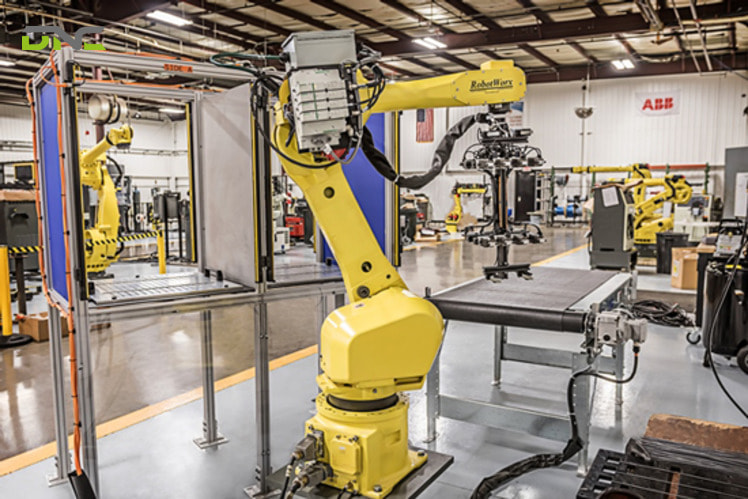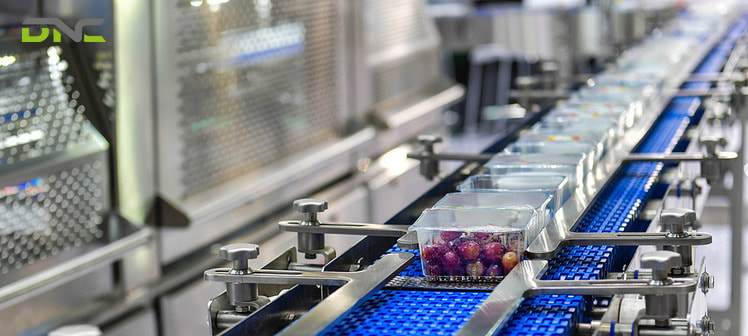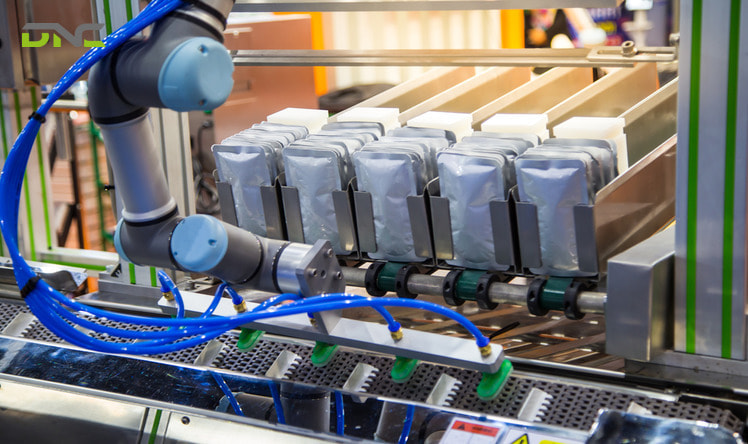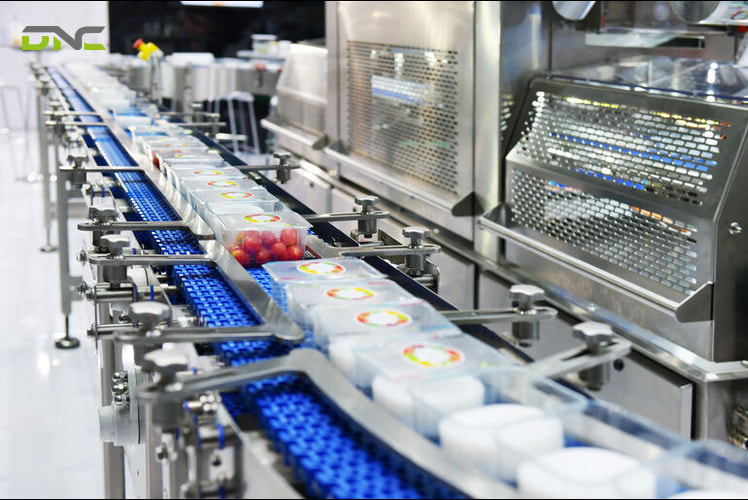Smart Food Packaging Robots for Faster, Safer, and Cleaner Production Lines
Food packaging robots are transforming how food products are packed, sealed, and palletized. With advanced vision systems and hygienic designs, they deliver faster, safer, and more consistent results — helping manufacturers meet modern demands with DNC Automation’s smart solutions.
What Are Food Packaging Robots?
Food packaging robots are automated machines designed to handle various packaging processes in the food and beverage industry — from sorting and filling to sealing, labeling, and palletizing. Unlike traditional manual or semi-automatic systems, these robots use advanced motion control, sensors, and vision systems to execute repetitive and precise tasks with speed, accuracy, and consistency.
One of the biggest advantages of robotic packaging systems is their ability to maintain high hygiene standards — a critical factor in food manufacturing. Many food packaging robots are built with stainless steel frames, IP-rated washdown enclosures, and food-grade materials to ensure compliance with international safety standards such as HACCP, ISO 22000, and FDA/EFSA regulations. These designs allow easy cleaning, prevent contamination, and ensure long-term reliability in demanding production environments.
Food packaging robots can perform multiple operations across the production line — including picking and placing products, arranging them into trays or cartons, weighing and labeling, and even stacking sealed packages onto pallets for dispatch. By automating these labor-intensive processes, manufacturers can achieve higher throughput, improved product consistency, and reduced operational costs.

Food packaging robots are automated machines designed to handle various packaging processes in the food and beverage industry
How Do Food Packaging Robots Work?
Food packaging robots combine precision mechanics, smart sensors, and advanced software to automate the entire packing line — from product infeed to palletizing. Their goal is to increase throughput, ensure hygiene, and maintain consistency, all while operating in high-speed, often temperature-controlled environments. Below are 8 steps explanation of how these systems typically function:
Step 1 — Product Infeed and Alignment
Every robotic packaging process begins with the infeed system, where products are fed into the robotic cell via conveyors or feeder systems. The infeed ensures that each item arrives at a consistent speed, spacing, and orientation, ready for robotic handling. Sensors or photoelectric detectors help synchronize the product flow with the robot’s picking cycle.
- Hygienic conveyor systems (modular belt, vibratory, or incline conveyors)
- Product spacing and accumulation modules
- Stainless steel or washdown-grade frames (IP67/IP69K)
- Servo drives for precise flow control
Step 2 — Product Detection and Sorting
Once products reach the inspection area, machine vision cameras and sensors identify and categorize them. Vision algorithms analyze attributes such as shape, size, color, barcode, or expiration date, while AI-powered sorting ensures defective or misaligned products are removed before packaging.
- 2D/3D vision cameras and AI vision processors
- Barcode/RFID readers and laser scanners
- Weighing modules and defect detection systems
- PLC integration for synchronized rejection systems
Step 3 — Robotic Picking and Placing
Next, robots take over the manual, repetitive, and hygiene-sensitive task of picking products and placing them into packaging.
Depending on the product type, different robot models are used:
- Delta and SCARA robots handle lightweight, high-speed items (e.g., biscuits, candies, bakery goods).
- Articulated arms manage heavier or irregular products (e.g., frozen meats, bottles).
- Collaborative robots (Cobots) work safely alongside humans for flexible packaging tasks.
Step 4 — Sealing, Wrapping, and Secondary Packaging
After filling trays, pouches, or containers, robots hand off to automated sealing or wrapping systems. Heat sealers, form-fill-seal (FFS) machines, or flow wrappers close and protect products.
- Heat sealing, vacuum sealing, or flow wrapping systems
- Automated tray formers and carton erectors
- Servo-driven actuators for consistent seal pressure
- PLC-based synchronization between robot and wrapper timing
Step 5 — Labeling, Coding, and Final Inspection
Before dispatch, the system applies labels, barcodes, or QR codes and prints batch or expiry information. High-speed vision inspection verifies correct label placement, barcode readability, and packaging integrity. Faulty packs are automatically rejected for rework or disposal.
- Thermal inkjet / laser coders
- Automatic label applicators
- Vision inspection cameras
- Reject gates with PLC interlocks
Step 6 — Case Packing and Robotic Palletizing
The final packaging phase involves grouping finished products into cartons and stacking them onto pallets. Robotic palletizers create optimized stacking patterns to ensure stability during transport. For frozen or heavy food products, gantry-style palletizers or collaborative cobots handle the load, minimizing worker strain and maximizing throughput.
- Case packers and robotic palletizers
- Pallet dispensers and stretch wrappers
- Pallet conveyors integrated with AGVs/AMRs
- Load sensors for balance and safety verification
Step 7 — Real-Time Monitoring, Traceability, and Data Feedback
Throughout the process, every action is tracked digitally. Sensors and controllers collect data such as temperature, weight, speed, rejection rates, and batch codes. This data is fed into IoT or MES platforms for traceability, analytics, and predictive maintenance alerts.
- IoT gateways and cloud platforms
- WMS / MES / ERP integration
- SCADA and HMI dashboards
- Predictive analytics and data visualization
Step 8 — Centralized Control and System Integration
At the heart of the operation is a PLC or industrial PC that coordinates every subsystem — from robots and conveyors to labelers and palletizers.Integration with higher-level systems such as WMS (Warehouse Management System) or MES (Manufacturing Execution System) ensures seamless communication, scheduling, and batch management across the factory.
- PLCs (Siemens, Allen-Bradley, Omron)
- HMI touch panels for operator interface
- OPC-UA / MQTT communication protocols
- WMS / MES / ERP data synchronization

8 steps explanation of how these systems typically function
What Are the Benefits of Food Packaging Robots?
Food packaging robots bring measurable improvements to productivity, hygiene, and product quality across the entire production line. Below are the key advantages manufacturers can expect:
- Increased Efficiency and Throughput: Unlike human operators, robots can work continuously 24/7 with minimal downtime. They handle repetitive tasks at consistent speed and precision, resulting in higher output and faster order fulfillment.
- Enhanced Hygiene and Food Safety: In food manufacturing, hygiene is critical. Robots minimize human contact with products, drastically reducing the risk of contamination..
- Improved Accuracy and Consistency: Automated systems ensure precise portioning, sealing, and labeling, maintaining uniform product quality across all batches. Vision-guided robots detect any misaligned or damaged products before sealing, ensuring zero-defect packaging.
- Reduced Labor Dependency and Cost: With rising labor shortages and turnover in the food industry, robotic packaging provides a stable and scalable solution. One robot can perform the work of several operators, reducing manual labor costs by 20–40% while freeing staff for higher-value tasks such as quality control and line management.
- Scalability and Flexibility: Modern robots are designed to adapt to new SKUs, packaging sizes, and product types quickly. Changeovers can be completed with minimal downtime, helping manufacturers respond faster to market demands and seasonal variations.

Benefits of Food Packaging Robots
Key Technologies Behind Robotic Food Packaging
Behind every efficient food packaging robot is a combination of smart hardware and intelligent control systems. These technologies work together to ensure hygiene, accuracy, and traceability in every operation.
- Vision Systems and Object Recognition: High-resolution 2D/3D cameras identify product positions, shapes, and defects in real time. They guide robots to pick, place, and inspect with pinpoint accuracy — even when items vary in color or texture.
- AI and Machine Learning: Artificial intelligence helps robots learn from data and optimize their performance. AI-based sorting and motion planning enable predictive control — automatically adjusting robot speed, path, or grip pressure based on real-time conditions.
- Food-Grade Grippers and End-Effectors: Grippers are made from FDA- and EFSA-compliant materials, such as silicone or stainless steel, to handle food safely. Soft grippers and vacuum systems allow delicate products (like pastries or fruits) to be packaged without damage.
- Seamless Integration with Automation Systems: Food packaging robots connect to conveyors, WMS/WCS, MES, and ERP systems, forming a fully automated ecosystem. This integration ensures smooth product flow, real-time data exchange, and complete traceability across production and logistics.
Challenges and Considerations Before Implementing Food Packaging Robots
While robotic food packaging offers significant benefits, there are also key factors to evaluate before implementation:
- High Initial Investment: Robotic systems require capital investment in robots, conveyors, and vision components. However, with ROI typically achieved within 1–3 years, the long-term operational savings outweigh upfront costs.
- Regulatory and Safety Compliance: Food packaging robots must meet international food safety standards such as HACCP, ISO 22000, and local Malaysian regulations (MeSTI, GMP). Choosing compliant equipment and materials ensures certification and export readiness.
- Environmental Constraints: Packaging environments can vary in temperature, humidity, and product condition (e.g., frozen or oily items). The robot’s design, IP rating, and material selection must match these conditions to maintain performance and hygiene.
- Maintenance and Local Expertise: Ongoing maintenance and troubleshooting require technical support. Partnering with a provider that offers local service teams and spare part availability helps minimize downtime and reduce service costs.
- Workforce Training and Change Management: Operators must learn to supervise and maintain automated systems. Providing on-site training and clear SOPs ensures a smooth transition from manual to robotic operations.

While robotic food packaging offers significant benefits, there are also key factors to evaluate before implementation
Why Choose DNC Automation for Food Packaging Robotics in Malaysia?
As a leading automation solutions provider, DNC Automation delivers end-to-end robotic packaging systems tailored for the food and beverage industry. Here’s why leading manufacturers trust DNC:
With over 10 years of experience, DNC has successfully implemented robotic solutions for food, beverage, and FMCG factories across Malaysia and Southeast Asia. DNC designs and integrates custom end-of-line solutions, including robotic pick-and-place, case packing, palletizing, and vision inspection — all tailored to your plant layout and production capacity.
From conveyors and AGVs to SCADA, MES, and WMS systems, DNC ensures your packaging line operates as a fully synchronized ecosystem. DNC’s Malaysian-based engineering team provides installation, commissioning, operator training, and after-sales support — ensuring your automation investment delivers long-term reliability and ROI.
- 5 views
- 0 Comment




Recent Comments